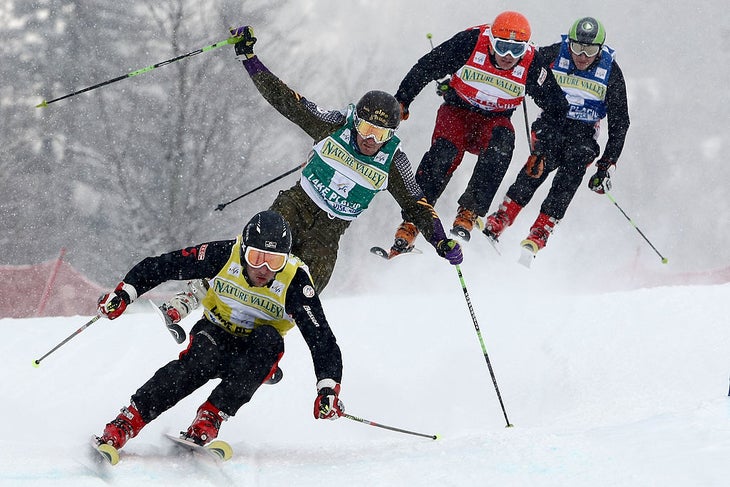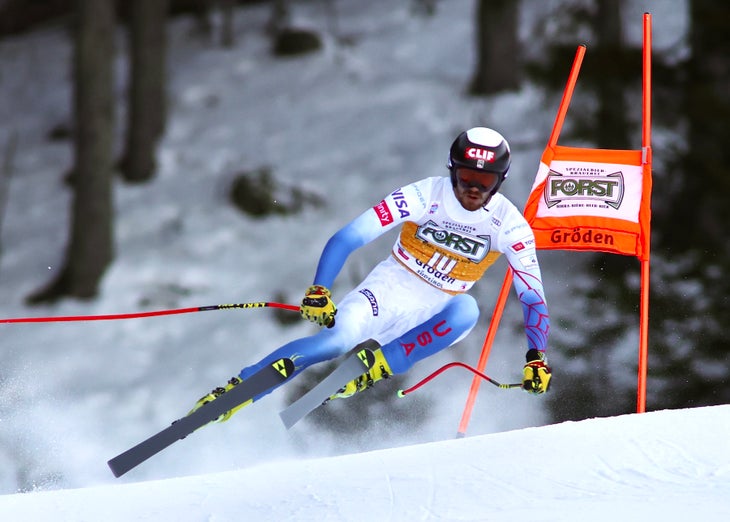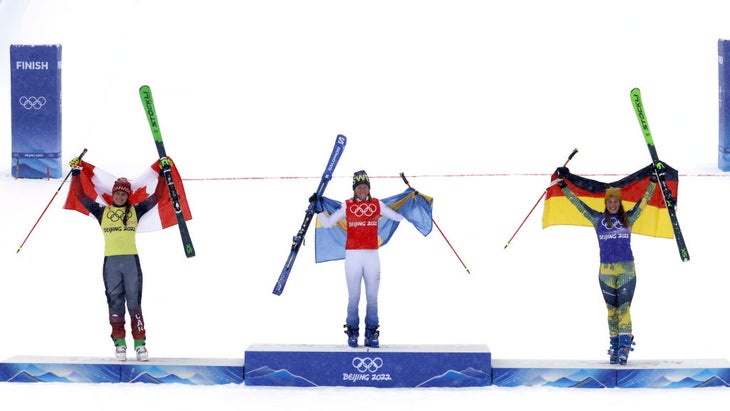Products You May Like
Ski cross competition is underway at the Beijing Olympics and, once again, the U.S. has failed to produce a full team. In fact, a U.S. Ski and Snowboard spokesman says it has “no national team.” Instead, it has a lone entry: Tyler Wallasch, a self-funded competitor from Mammoth who, against all odds, produced a fourth-place finish on the World Cup in December.
Yet our neighbor, Canada, has captured one-third of the Olympic medals in this discipline since ski cross made its Olympic debut in 2010.
“We are scared of the States, if they ever get their act together,” says Stanley Hayer, Canada’s head coach and an Olympian in both alpine and ski cross.
For one thing, Hayer says, look at the depth. Right now, there are only 656 FIS-licensed alpine racers in all of Canada; the US has more than twice that. Add the number of college programs here, and the number is probably ten-fold.
In fact, one of Canada’s entries in Beijing came out of the U.S. college system. Kevin Drury placed second for the University of Vermont in giant slalom at the 2011 NCAA championships. He went on to win the World Cup ski cross globe in 2020.
But it’s rare that U.S. alpine athletes will banter about head-to-head racing on a single course during their primes. Ask Daron Rahlves.
“Bode never talked about it with me,” said Rahlves, “but I was keeping tabs on it when I was racing. My buddies Zach and Reggie Crist went into ski cross when I was still on the World Cup, then Casey Puckett, Jake Fiala… all guys I spent time with on the alpine tour.”
Rahlves did, however, dash out for one event while he was still on the alpine team. “My buddy Uncle E called [in 2000] and said, ‘Hey, we got this Lord of the Boards deal’” right after U.S. Nationals. It was about 10 grand for the win. So Rahlves waxed up and won.

Back then, the X Games was the premier event. Then FIS (the International Federation of Skiing) added World Cup races in 2002. “But the FIS tracks weren’t that fun,” Rahlves said. “There were a lot of turns, just one after another, so there wasn’t enough passing. My last year I raced FIS, to qualify for the [2010] Olympics, they were starting to get a little better as far as variety and options.”
Another problem was that FIS placed ski cross in the freestyle bucket which means that ski cross athletes must battle for Olympic quota spots against all the other freestyle disciplines (aerials, moguls, ski halfpipe, slopestyle, and big air). The Olympic freestyle/freeski quota is 30 athletes per country, and no more than four men and four women per event. Canada is using eight of its slots for ski cross in Beijing, and it still has 10 more athletes sitting at home.
Related: The controversial reason why the U.S. men’s alpine team is the smallest it’s been in decades
The scenario could look quite different at the 2026 Olympics in Milano-Cortina, Italy, however, because FIS finally moved ski cross into the alpine category at its fall meeting in 2020, but they won’t begin to sort out the details until May 2022, so it could be years before Alpine skiers try to earn World Cup points on the ski cross circuit.
Until then, a stigma remains—at least in the U.S. After Rahlves retired from alpine racing with a World Championship gold medal in super-G, he said, “I had a bunch of people come up to me saying you’re crazy for jumping into ski cross. One, you get hurt. Two, you can tarnish your reputation as one of the greatest ski racers when you get beat. I was laughing at ‘em. I was like: I don’t care! I was battling just to stay in the mix, but it was super fun.”
Rahlves went on to win the Winter X Games equivalent of ski cross in 2008. It made him wonder why more U.S. alpine athletes weren’t interested in the sport. In fact, he thought they might benefit from the cross training. “I think alpine skiers should be training a bit of ski cross because it gives you a sense of how to make speed in terrain, milk the terrain, squeeze everything out of it possible.”
“Bryce Bennett, for example, would be great,” Rahlves said. “He knows terrain really well. He won the Val Gardena downhill this season. He’s out on the pump track of BMX on a mountain bike in the summer. Errol Kerr, who skied for Jamaica in the 2010 Olympics, is the same way–so good on a bike.”

Drury, the 2022 Canadian Olympian, made the transition from alpine in two or three years. But it can take a while for alpine racers to get used to the proximity of other athletes on a course.
“At first, it feels like someone’s right behind you,” Hayer said. “People freak out, thinking I’m way too close. But then you watch video, and they’re 30 feet behind you. Once they get comfortable in that situation and understand the cause and effect of certain decisions, they’re good.”
To gain spacial awareness, Rahlves and Casey Puckett would go into a single GS course and ski it side by side. “It was tricky,” he admits. “If you’re on the inside, you’d better not go too wide. If you’re on the outside, you’d better have a round enough line to give space to the inside guy. We were like fighter pilots rippin’ down the hill, side by side. It was definitely a little dicey.”
In 2010, Rahlves and Puckett comprised the largest U.S. Olympic ski cross team in history, but both men were eliminated in their opening heats. Four years later in Sochi, the same fate befell the lone American, John Teller (a self-funded auto mechanic).
Still, Rahlves said, “I thought it was one of the most exciting things I’ve ever done. But there’s no support for it in the U.S.. It’s pretty sad.”

In contrast, Canada currently has 18 ski cross athletes, five coaches and four ski techs year-round. When Hayer was asked what he would do if he had the keys to U.S. resources and talent, he immediately said, half-joking, “Is there an option for that? Is someone looking?”
“Plain and simple. Funding” he said. And structure.
“In alpine, skiers know: I’m gonna make the regional team, I’ll make selections, I’ll be able to go to Europe, I’ll be in World Juniors,” Hayer said. “Then, if it works out, I’ll make the development team and national team. If that doesn’t work out, maybe I can go to university. It’s not an option in ski cross right now. “
“And then you need a certain number of athletes racing at a high level to be competitive,” he continued. “You need at least four people to make a heat in training. You’ll have some injuries, so a 16-person team is optimal, eight per gender. You could probably do it with 10. Then you start crunching the numbers for that. It’s doable.”
The U.S. has so many good skiers, says Hayer, we could easily put together a 10-man team that would probably be competitive right off the bat. “All you have to do is come up with a four-year program and say we are going to support this many people. You’ve gotta have some [experts] with good eyes to grab the best, keep building, hopefully have a good Olympics, and it kind of snowballs from there. But there’s got to be some trust in the system.”
And yes, Hayer said, it’s possible to make a living in ski cross, “but you have to be winning.”
Sandra Naeslund of Sweden is currently dominating the sport on the women’s side. She won eight of the nine World Cups this season and just broke Canada’s grip on Olympic gold in Beijing on Wednesday. She makes over 11,000 Euros (about $12,500 US) for every World Cup win.
“Which isn’t Kitzbühel money,” Hayer says, but she has sponsors, so she’ll make more than $100,000 US this year. “We’re hoping prize money goes up when we’re [part of FIS] alpine.”
Ultimately, Hayer concluded, “All of us have said all along: the numbers favor the U.S. They just never looked at it as a source of Olympic medals. It’s under your umbrella. You should take care of it. They’re waiting for results but oh, we don’t have any results.”
It’s true.
“There would be a national team ‘if and when’ there are athletes who achieve criteria,” said the U.S. Ski and Snowboard spokesman.
For the A team, that means winning Olympic gold in Beijing, winning a World Cup race, or earning a pair of podiums on the Tour by March 29, 2022. Or, for the B Team, by placing in the top-8 twice on the World Cup.
On your own dime, that is. Good luck.
